1. Feature Overview
This connector captures real-time lead information about e-commerce customers who add items to their carts on Shopify but do not complete the purchase on the check-out page due to various reasons. The data captured includes cart details such as abandoned checkout URL, product ID, product name, and price. This information is then mapped in real-time to your LeadSquared account. Once the leads are synced, you can utilize LeadSquared’s CRM features to nurture and convert these leads effectively.
2. Prerequisites
- You must be the Administrator of your LeadSquared account.
- You must have an active Shopify account.
3. How it Works
Capture lead data from your Shopify account in LeadSquared by configuring the Shopify connector. Once configured, enable the connector sync.
During configuration, a webhook URL is generated in LeadSquared. Copy this URL and configure it in your Shopify account.
4. Install the Connector
- Navigate to Apps>Apps Marketplace.
- Search for Shopify(Abandoned Checkout), and click Install.
- Alternatively, you can find the connector on the left panel, under Lead Capture.
- Once installed, hover your cursor over
 , and click Configure.
, and click Configure.
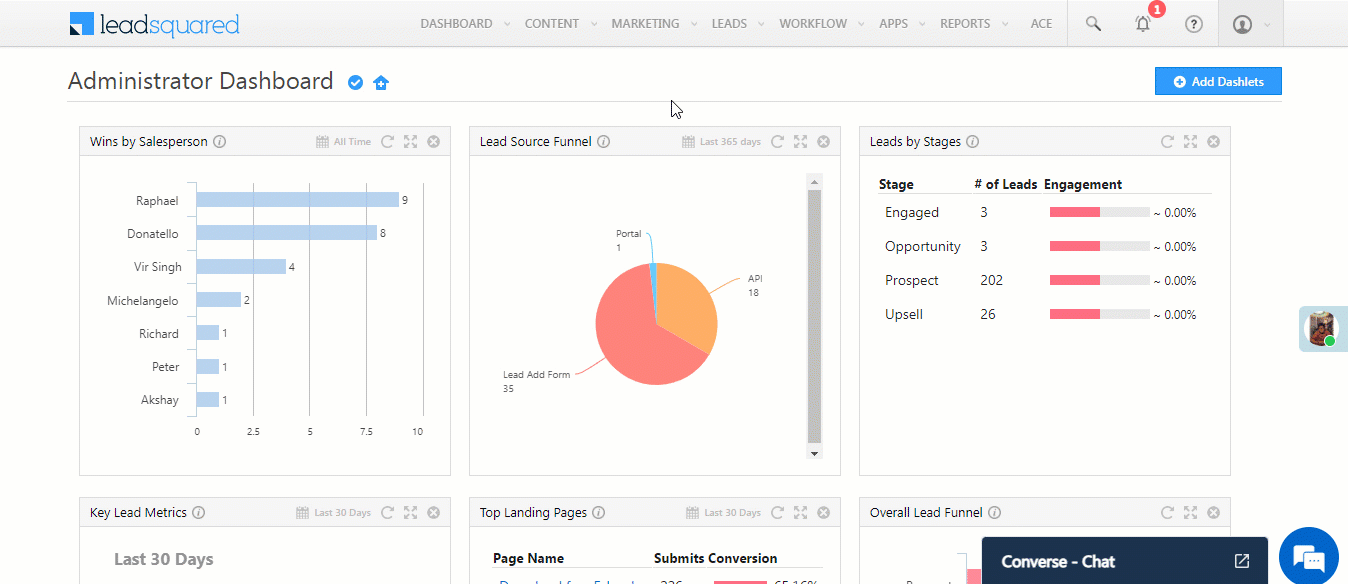
5. Configure the Connector
Once you’ve installed the connector, on the Configure Shopify(Abandoned Checkout) pop-up, configure the connector access for the non-Admin users in your account. Only those users for whom access is granted can view and access the connector (under the Apps main menu).
- Select if you want to grant Connector Access that’s Based on Role or Advanced (User Level).
- Based on Role – From the Specify Roles dropdown, select the LeadSquared user roles that can use the connector.
- Advanced (User Level) – From the Advanced (User Level) dropdown, select a user boolean field. Based on the value entered in the selected boolean field, the user can access the connector (e.g., for the user Sam, if the “Is Employee” boolean user field contains the value “Yes”, then this user can access the connector).
- Once you’re done, click Save Details. To continue the configuration, refer to the below sections.
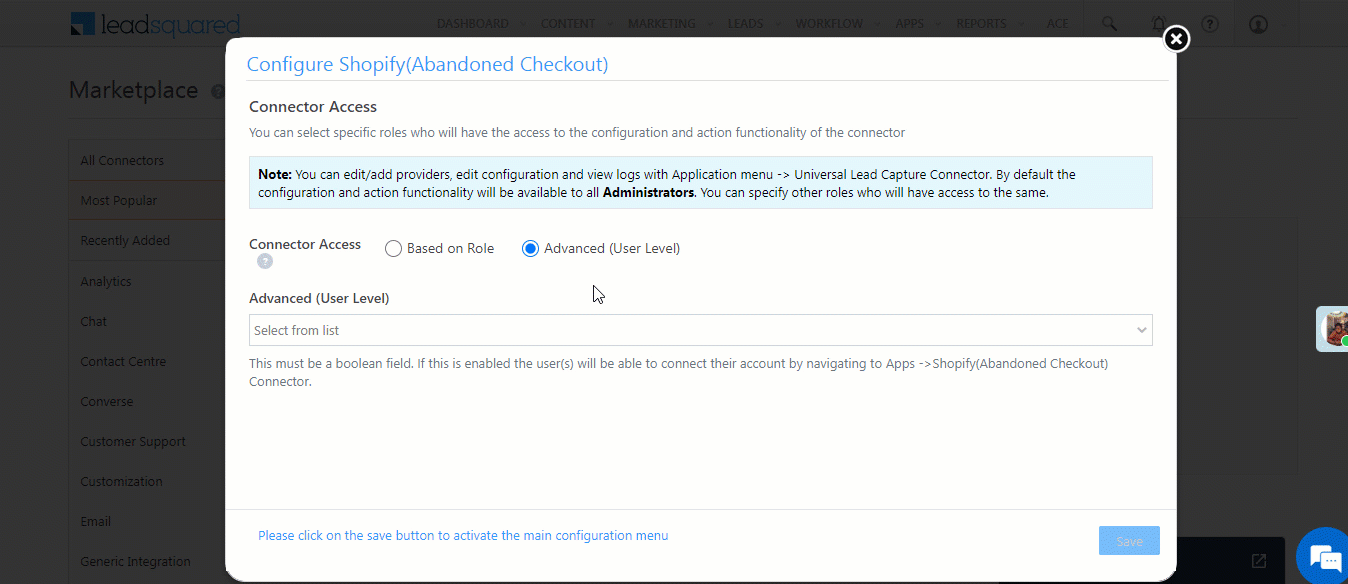
6. Admin Configurations
To continue the connector configuration, navigate to Apps>Shopify(Abandoned Checkout).
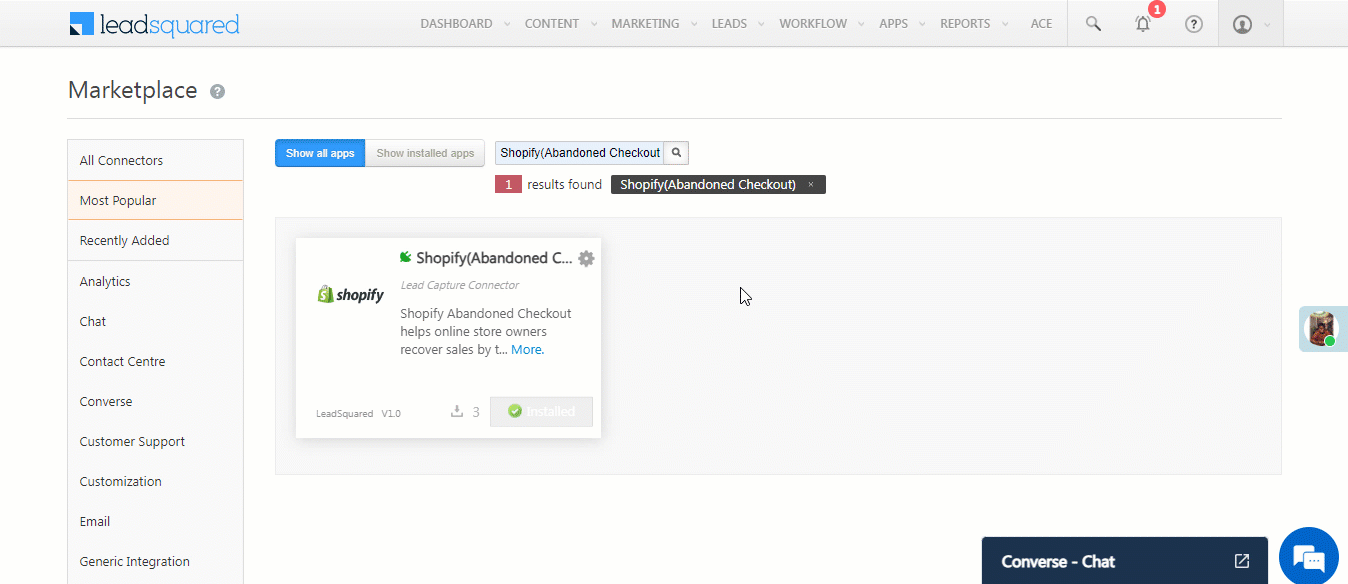
6.1 Basic Details
Enter the following details –
| Property | Description |
| Lead Source | Enter the lead source through which the leads were captured (e.g., Shopify, email campaign, etc.). This detail will be displayed on the Lead Details page, under Lead Source. |
| Default Country Code | If the lead’s mobile number is captured without a country code, then the default country code that’s selected from the dropdown will be added to the lead’s mobile number. |
| Select Time Zone | The time zone followed in your Shopify account. |
| Lead Capture Search By Criteria | To avoid creating duplicate leads, you must select one unique lead field (e.g., email Id, mobile number, PAN number, etc.) as the search key. To know how to mark a LeadSquared lead field as unique, please refer to How to Make a Custom Field Unique. |
| Lead Capture Secondary Search By Criteria | If lead identification and capture through the primary Search By Criteria fails, it will be re-attempted using the secondary Search By Criteria. |
| Select User to Notify on Failure | If there is an error in fetching leads, the selected user will receive a failure message via email. You can select a user from the list of all the users available in your LeadSquared account. To know more about the type of errors, please refer to Error Notifications. |
| Enable Notification | To ensure notification emails are sent to the selected user when there’s a failed query, enable the |
Once you’re done entering all the details, click Save & Next.
6.2 Mapping
Once you’re done with the basic settings, click Entity Options. By default, all the Shopify fields are mapped to the corresponding LeadSquared lead fields. You’ll have to complete two steps here –
- Enable Activity Creation* – Alongside Shopify abandoned cart, click the Create Activity button.
- Edit Mapping – Alongside each action (Activity Entity and Lead/Contact Entity) click the Edit Mapping button to verify if the field mapping is accurate. Once verified, click Save & Close. This step is mandatory.
If required, on the Edit Mapping pop-up, you can edit the field mapping –- To edit the Shopify mapping field name, click
 , and under Mapping Key, edit the field name.
, and under Mapping Key, edit the field name. - To change the LeadSquared lead field to which the Shopify field is mapped, click
 , and from the Lead Field dropdown, select the new lead field.
, and from the Lead Field dropdown, select the new lead field. - To mark a unique lead field as the search key, click
 .
. - To disable an existing field mapping, alongside the field, disable the slider
 .
. - To map an additional field, click the Add Custom button, and add the new mapping field details.
- If you want to capture any additional responses as part of the activity that’s posted on the lead, alongside Activity Entity, click Edit Mapping, and add the response on the Default Mapping for Activity pop-up.
- To edit the Shopify mapping field name, click
Once you’re done, click Save & Next.
Note:
- *Ensure you complete the Enable Activity Creation steps first, and only then complete the Edit Mapping steps.
- You must mandatorily verify the mapping for Lead/Contact Entity, and Activity Entity, and click Save & Close for each action type, in order to complete the Mapping.
- Since this connector is capturing the payment details as an activity, the Sync Behaviour is by default set to Do Nothing. It is recommended you don’t change this to any other setting.
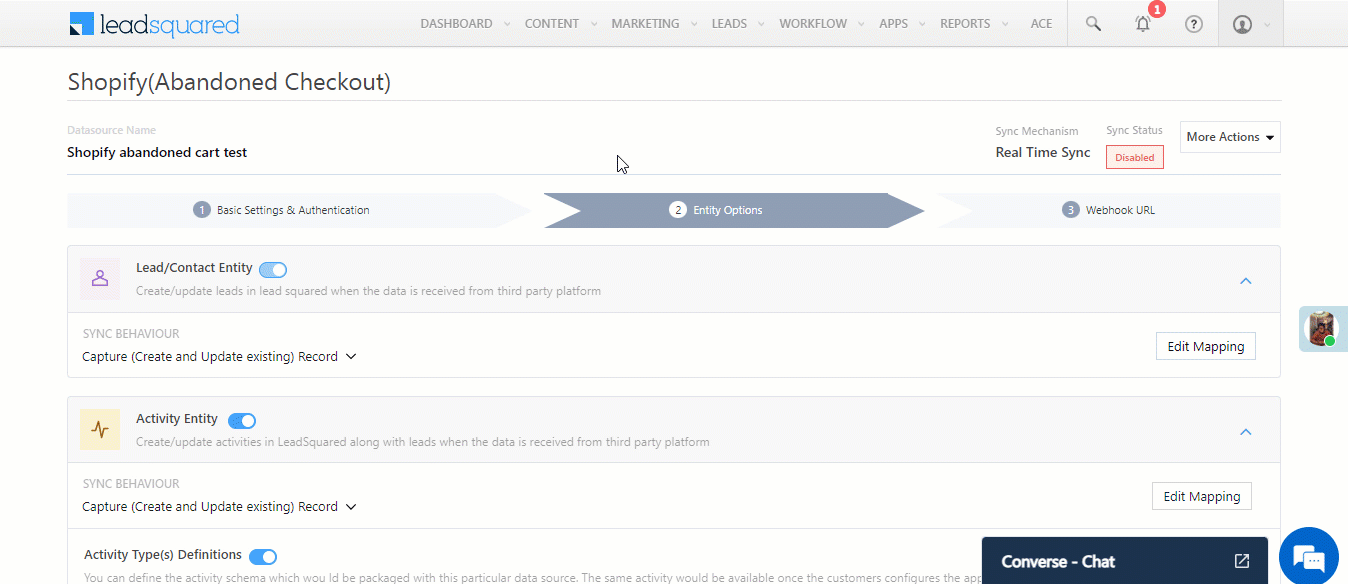
6.3 Webhook URL
After you provide basic details and finish field mapping, a custom webhook URL is generated. Copy this webhook URL, and use it to create a webhook in your Shopify account.
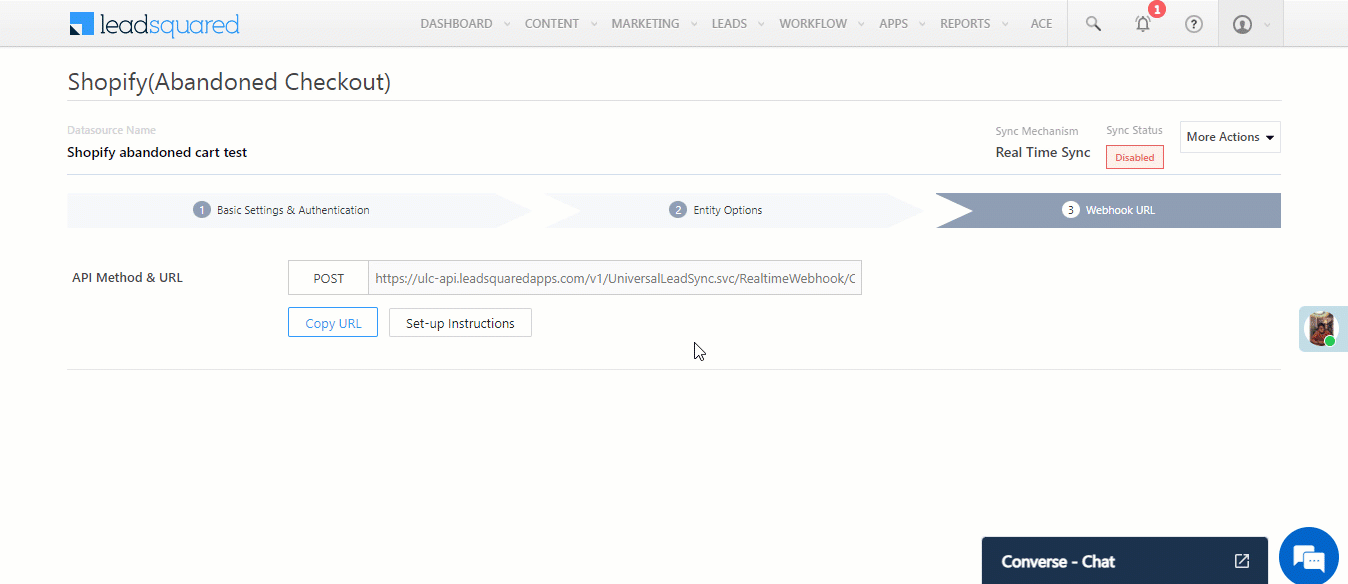
7. View Logs
Here, you can view logs of all the sync jobs that have taken place.
- Navigate to Apps>Shopify(Abandoned Checkout), and click More Options, and then click View Logs.
- You can filter the logs by selecting a date range (Today, Last 7 Days, This Month, and Last Month), by selecting the Job Status (“All”, “Success” and “Failure”), and by selecting the Sync Status (All, Error, and Success).
- You can view the sync status of the following events –
- New Events – List of all the new payment activities posted in your account.
- Errors – The list of unsuccessful payment activities that have not been captured due to mapping errors (e.g., when a boolean field is mapped to an integer field, etc.).
- To view the Sync Response details, under Request ID/Sync Job ID, click the Id.
- Under the right panel, you can view the response status, the API URL, the request, and the response.
- The responses that are successful will contain the details of the leads that have been pushed by Razorpay.
- To view the lead capture response under Sync API Response, Leads Updated and Errors in Leads, click
 .
.
Note:
- For a response that contains an error, the reason for the error is listed in the response. Once you fix it, you can click the Retry button to perform the sync again.
- The current Lead/Activity Sync Behaviour will reflect in the Logs screen. This will help identify the sync that’s used (Capture or Update) for the selected Request/Sync Job Id.
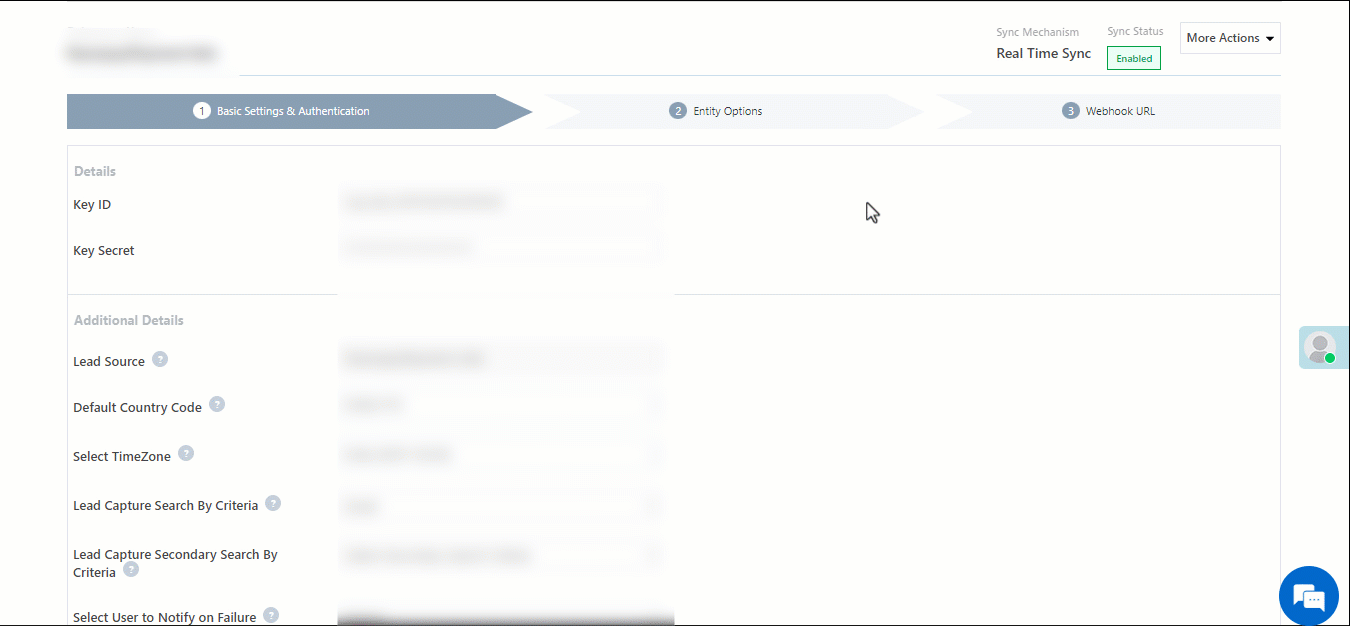
8. Other Actions
You can edit or delete the Shopify(Abandoned Checkout) connector that you created. To do this –
- Navigate to Apps>Apps Marketplace and search for the Shopify(Abandoned Checkout) connector.
- On the Shopify connector, click Settings.
- From the list of options, you can perform the following actions –
- Edit Configurations
- Disable the connector
- Remove the connector

9. View Reports
You can view the total number of leads that have been pulled from Shopify, by referring to the Lead Source report. To know more, please refer to How to track the source of your Leads using Lead Source Report?
Any Questions?
Did you find this article helpful? Please let us know any feedback you may have in the comments section below. We’d love to hear from you and help you out!






